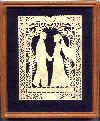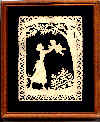Scherenschnitte
All you need for creating scherenschnitte is time, patience, a steady hand and a few inexpensive supplies. The designs can range from small, simple ones to intricate,detailed 'masterpieces' and once you learn the craft you can experiment with various papers, colors, frames and projects. You can make your own unique frameable gifts, cards, invitations, notecards, and many more projects with this simple craft. If you are a first time Scherenschnitte crafter, it is best if you go over all the instructions before you start your project. MATERIALS and EQUIPMENT 
Parchment paper
1. Making a pattern- b. Trace it unto the parchment paper. 2. Cutting the design- b. Cut out the central part of the design first, starting with the most intricate details. Scherenschnitte crafters differ in opinion about which they prefer - the scissors or X-ACTO knife/blade cutters, so try out both and discover which you are more comfortable with for the various parts of the design. If you prefer the scissors, start by holding the scissors underneath the central part of the design, punch a tiny hole through the area to be cut out, to insert blade. Cut out the space, feeding paper into the scissors and keeping the scissors moving in a steady rhythm with small cuts. c. If you use the X-ACTO knife/blade cutter, you may want to practice first on folded scraps of similar paper. Practice cutting curves as well as corners (for a clean corner, make a slight overcut where the two cutting lines meet). For folded designs, you'll also have to make sure that you are putting enough pressure to cut through the two layers. d. Cut slowly and carefully, keeping the image of the design in mind; rest your eyes frequently by looking away at the horizon. Continue cutting out spaces, working towards the edge. Cut the outer edges of the design last of all, using the scissors. e. As you work, you may find it helpful to enclose the cutout portion with a "sleeve" (two pieces of paper taped together at the edges). f. If there are dots in the design, prick through the dots with the large pin. g. Carefully remove the tape, open the cutting (if it is folded) and check for any uncut details. h. Turn the cutting over so that any design markings which have not been cut out are on the underside. i. Press flat between the pages of a heavy book until you're ready to antique, color, or mount. 3. Antiquing or coloring (optional) - Your finished cutting is good for mounting as it is but you may also antique or color it if you prefer. a. For antiquing, brew a strong coffee or tea, let it stand for a few hours and pour into a glass baking dish or plastic container. Dip the cutting in the dish and drain on newspapers topped with paper towels. You may also blot (with a clean rag or paper towel) or paint the cutting with the coffee or tea. You may use several dippings or blottings but make sure to let the cutting dry between applications. Make sure your cutting is completely dry before lettering and mounting. b. If you are making more than one cutting, make the most of your coffee or tea stain by staining all your cuttings at the same time. c. You may also color your cutting using watercolor, colored pencil or waterbased markers. 4. Lettering- b. A favorite saying or meaningful quotation can be added to portions of your papercutting and names, dates and other certificate information can be used to personalize your project. For a new baby, make a papercutting which contains the name, date and time of birth, weight, length and place of birth. For a wedding or anniversary, make one with the couple's names, the date of the marriage and other meaningful information. A simple papercutting, personalized with a name makes a great gift. c. There are various lettering styles which you can use for your papercutting. Even your own handwriting could be very pleasing. Try using the lettering examples as a guide for your own lettering. d. First write out your message or other information on graphing or ruled paper, using the lines as a guide to make even letters. Take note of how much space you have in your papercutting and adjust your lettering size or message to fit nicely into the space. Rewrite the message until you are satisfied with the way it looks. e. Position your message under your cutting and lightly trace the lettering with a pencil unto your cutting. If it is difficult to trace, try taping the two pieces of paper against a sunny window. Make your final adjustments and ink over the pencilled lettering using a fine nibbed calligraphy pen. 5. Mounting and Finishing- b. Position your completely cut parchment design on the backing paper before applying any adhesive to it. Make sure that the design markings are on the underside. Holding one side of the cutting firmly with your hand, place tiny dots of glue on the back of the free side of the cutting. Press down on the glued side and repeat for the other side. c. If your cutting has a center fold, you may position it by putting marks on the center top and bottom of the backing paper and with a ruler, aligning the center fold line with these marks. 6. Framing- If you decide to frame your papercutting, choose a frame with glass to protect the cutting. Many designs fit standard picture frames. You may either leave a border of backing paper if you are using a bigger frame or you may want to cut the backing paper to eliminate the border to fit a smaller frame. Examples: Wedding Scherenschnitte, Mother and Daughter This great background is from netCreators. Won't you please sign my guestbook?Would you like to view my guestbook?
This page hosted by |
